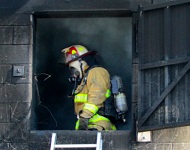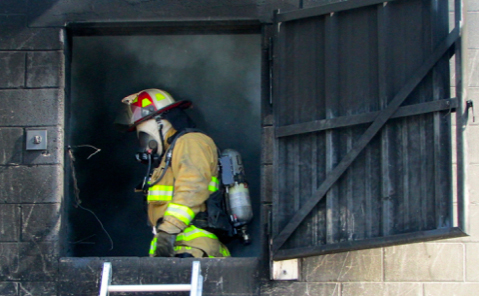

By Jim Burneka Jr.
Scenario: The wail of the sirens die down, and the flames no longer exist. The room-and-contents fire has been successfully extinguished in routine fashion. The scene threat level drops from an elevated risk to low risk. It seems all imminent danger has been extinguished along with the flames.
However, placing the fire under control does not mean that you are completely out of the “danger zone.” Firefighters still have one significant threat looming in the atmosphere: cancer! There is a cause-and-effect relationship regarding firefighting and cancer. However, unlike a broken leg (that is obvious), the effects of fighting fires can take 10-25 years to surface because of latency periods. It’s important to know what steps firefighters can take during overhaul and cleanup that will ultimately decrease their risk of being diagnosed with occupational cancer.
A huge misnomer in the fire service is that once your atmospheric monitors read below 35 parts per million (ppm) of carbon monoxide (CO) and below 5 ppm for hydrogen cyanide (HCN), it is safe to remove your self-contained breathing apparatus (SCBAs) and other personal protective equipment to conduct overhaul. There is a multitude of other chemicals and carcinogens in the modern fire atmosphere that have no correlation to CO and HCN. Fire departments do not typically have the means to monitor for these chemicals and carcinogens, which places them in an unknown atmosphere. NFPA 1500, Standard on Fire Department Occupational Safety and Health Program, 7.07* states, “When engaged in any operation where they could encounter atmospheres that are IDLH or potentially IDLH, or where the atmosphere is unknown, the fire department shall provide and require all members to use SCBA.”
By now you’ve probably heard the statement, “Wear your SCBA start to finish, no exceptions.” The statement is completely true. The only way to fully protect our firefighters from inhalation exposures is by wearing our SCBA masks. Paper masks, N95 masks, and powered air purifying respirators will not protect us 100 percent of the time from inhalation exposures like an SCBA. Working with an SCBA is absolutely exhausting, but there is no other viable alternative. Having crews wear their SCBAs during overhaul is also logistically complicated. Our procedures on the fireground will have to change. Logistical issues that fire departments will have to consider include:
- Staffing. Crews that are normally released once the fire is under control should remain on scene and placed in the overhaul rotation.
- Air unit/Bottles. Command will need to make sure they have a large enough supply of air cylinders available. Apparatus can be fitted to carry extra cylinders, or an air truck may be brought to each scene to help refill our air cylinders.
- Rehab. A medic unit should be on scene to assess firefighters. According to NFPA 1584, Standard on the Rehabilitation Process for Members During Emergency Operations and Training Exercises, 6.2.2.2, “Members shall rest for a minimum of 20 minutes following the use of a second 30 minute or 45 minute self-contained breathing apparatus (SCBA) cylinder.” Firefighters should rehydrate during this break.
- City/Township coverage. Just because we have a working fire does not mean that all other emergencies cease to exist. We still must provide coverage for our city/township for the duration of the fire. Mutual-aid agreements can be arranged, or off-shift fire department employees can be called in to staff reserve equipment and provide coverage.
Once the fire is under control, some commanders like to evaluate the interior to see the extent of the damage for their report and figure out what resources they need to complete overhaul. Often, command will go into the structure with a fire investigator. They should wear their SCBAs while they are inside the structure. These individuals typically enter the structure right after the fire has been placed under control and the chemical off gassing is extremely high.
Use electric fans for the duration of overhaul to help dissipate the scene as much as possible. Don’t use gas fans overhaul because they release CO back into the fire environment.
RELATED: Brown on Colon Cancer ‖ Gillis on Prostate Cancer ‖ Baldwin, et al. on Controlling Diesel Exhaust Exposure
When a firefighter is able to take a break, it is important to rehydrate. Firefighters should place latex gloves or have someone with clean hands open up their bottles to avoid ingestion exposures. Rehab is also a great opportunity to use wet wipes to quickly clean their bodies.
Once overhaul is complete, firefighters should take a few minutes to decontaminate their gear. Fire departments can accomplish on-scene gross decon several different ways. Departments can assemble a decon bucket that consists of a water hose adapter, water hose, nozzle, brush, dawn detergent, and trash bags. In cold environments, firefighters would dry decon without using water. Place all gear into trash bags so they do not contaminate the cab of the apparatus. There are also appliances that you can place on apparatus to decon firefighters (much like decon at a hazmat scene).
Once you return to quarters, get your apparatus, equipment, and yourself back into service as soon as possible. You must decontaminate your SCBAs, hose, tools, and the apparatus interior. You must also place your soiled gear into a gear washer as soon as possible. It is imperative that you switch into a clean set of gear. If you continue to wear your soiled gear throughout your shift, you will expose yourself to contaminants through absorption every time you put on your gear.
Once your apparatus and equipment are in service, it is time for you to get in service. All crew members should take a mandatory shower. The showers should start off cold to close your pores and wash off any contaminates. Once you wash off the contaminants, you can turn the water to an uncomfortable hot level to open your pores back up and to get out some of the contaminants that you have already absorbed into your body. Ideally, take showers while the apparatus is still out of service. A crew member can then monitor a radio in case an urgent call is dispatched.
After a shower, change your uniform and wash the soiled uniform in a station clothes washer/dryer. Do not wash contaminated uniforms in personal washers/dryers to avoid cross contamination.
I also recommend that fire departments purchase infrared saunas for each station. Place small, stationary cycles into the saunas to allow firefighters to sweat out the toxins that their bodies absorb during firefighting activity. Each sauna costs approximately $5,000 to $10,000, depending on their size. Studies show that these saunas successfully rid the body of toxins that firefighters absorb while fighting a fire. Saunas in fire stations are common in Europe, and they have started to gain acceptance in the U.S. and Canada. Fire departments will have to show the benefits of Saunas to their firefighters and convince their cities/townships that Saunas should not be viewed as a luxury item.
After the equipment and firefighters are “back in service,” document the exposure that was just received. NFPA 1500, 4.6.2., states, “The data collection system shall also maintain individual records of any occupational exposure to known or suspected toxic products.” Firefighters should document every fire they are involved in, should they ever have to prove their exposures on a legal platform.
The fire service is big on risk management policies. “Risk a lot to save a lot, risk a little to save a little.” Take a second to think about these policies while you are conducting overhaul and cleanup. If you do not follow the above recommendations, then you are unnecessarily putting yourself and others at risk for occupational cancer……and for what?
We have all heard the saying, “Everyone Goes Home.” The goal should be to make it home and then stay around for a while. Firefighters need to take extra precautions and consider the big picture. The decisions that you make now will ultimately affect us all (and our families) in the future.
 Jim Burneka Jr. is a firefighter/paramedic with the Dayton (OH) Fire Department. Burneka has been involved in the fight against occupational firefighter cancer since 2007. He now serves as the president of Firefighter Cancer Consultants, LLC, and has formerly served as interim president of the Firefighter Cancer Support Network.
Jim Burneka Jr. is a firefighter/paramedic with the Dayton (OH) Fire Department. Burneka has been involved in the fight against occupational firefighter cancer since 2007. He now serves as the president of Firefighter Cancer Consultants, LLC, and has formerly served as interim president of the Firefighter Cancer Support Network.

